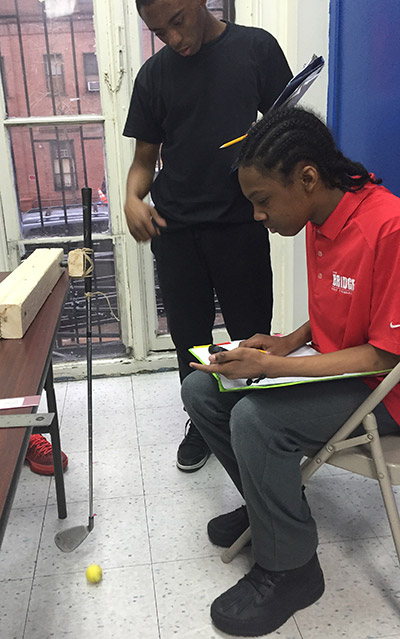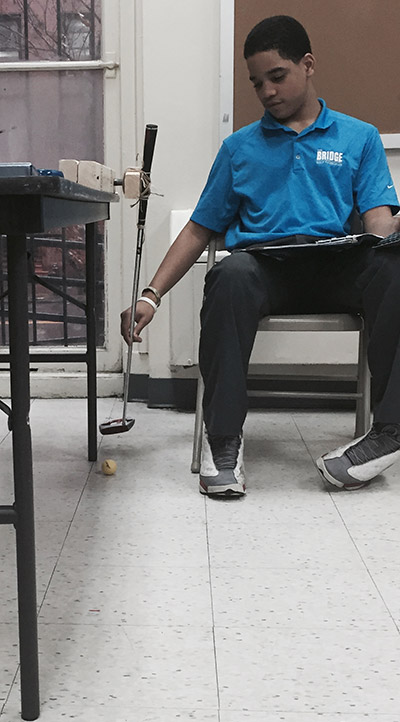 At one time or another, every golfer has been told to imagine the motion of a pendulum when putting. This week our students learned that the same smooth, back-and-through motion that can lead to holed putts can also lead to a greater understanding of the physics of golf.
At one time or another, every golfer has been told to imagine the motion of a pendulum when putting. This week our students learned that the same smooth, back-and-through motion that can lead to holed putts can also lead to a greater understanding of the physics of golf.
Matt Matzelle, our newest STEM instructor, and his colleague Veeshan Narinesingh channeled their inner carpenters for this experiment. With lumber, bolts, twine and golf clubs they built pendulums that rested on the table tops. (While serviceable for this experiment, it’s clear that our teachers have more of a future in physics than they do in woodworking.)
Instructors Matt, Veeshan and Tiffani Kolozian then worked with our students to conduct an experiment relevant to their unit on the conservation of energy. In this case, the students were working with a system that was not conservative, and their objective was to measure the energy lost when their club pendulums struck a golf ball.
 First, the students had to measure and record the mass of the ball and the clubhead. Next, they had to pull the club pendulum back to an angle and height of their choosing and measure the clubhead’s distance from the ground. Once they had the mass and height, they could calculate the potential energy of the pendulum. This angle was then marked on the wooden pendulum base so it could be re-created and the pendulum could be released in a consistent and controlled manner.
First, the students had to measure and record the mass of the ball and the clubhead. Next, they had to pull the club pendulum back to an angle and height of their choosing and measure the clubhead’s distance from the ground. Once they had the mass and height, they could calculate the potential energy of the pendulum. This angle was then marked on the wooden pendulum base so it could be re-created and the pendulum could be released in a consistent and controlled manner.
The next step was to hit a ball placed on the ground in pendulum’s path. This contact transferred the energy from the club pendulum to the ball. The students used stopwatches to measure the number of seconds it took the ball to cross a red line drawn on the floor 1 meter away. This allowed them to calculate the ball’s velocity (distance/time). The ball was struck five times in order to calculate an average velocity.
Once the students knew the ball’s average velocity and mass, they were able to calculate its kinetic energy. By subtracting this kinetic energy from the pendulum’s potential energy, they were able to determine how much energy was lost in the transfer from clubhead to ball.
What happened to that energy that went missing? The students correctly hypothesized some of the ways in which energy was lost — friction of the pendulum parts and air resistance, to name two — and determined that the biggest loss came from the friction between the golf ball and the floor.